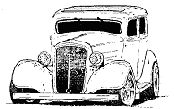Then And Now
The Street Rod Nats, Past and Present
By Gray Baskerville
Photography: The Rod & Custom Archives
When I hired on at Petersen in 1968, I figured every editor would be driving a hottie. Wrong! It took only a couple of days to realize that I was the solitary streeter, the only editor who actually made the daily commute—rain or shine, hot or cold, weekdays or weekends—driving a pre-’48, or in my case, my raggedy Deuce. That fact of strife wasn’t lost on the boys at Rod & Custom. Although I was hired on at the Specialty Publications Division of PPC doing the one-shots, annuals, and reprints, I immediately became a part of the R&C family thanks to a phone call from Tom Medley, then-publisher of the street rodder’s bible. “Are you the guy driving the roadster?” he asked. I answered yes and was invited to join in on the fun—like planning the first two Street Rod Nationals.
Peoria was the first, a shot in the dark that worked. The second was the real question mark. The feeling around R&C’s offices was a mixture of dread—Peoria could have been a fluke, so maybe nobody would show for the second one. There was also wonder—why would anyone make that midsummer drive from LA to Memphis and back in an old car just to look at more old cars?
Sadly, I was a no-go—both family and professional obligations put the kibosh on that move. Instead, I hung around Bud Bryan’s house on D (for depart) day waving adios to the Jaw (as we called Bryan) and the boys from R&C. I knew how important it was that R&C adhere to its “We Drove” commitment. Remember, these were the days when stretchers, LJ Buttera–speak for trailers, were frowned on. So it was essential that the magazine’s staff set a cross-country example, even if it meant making the long, hot, topless cruise in flathead-powered roasters.
I can’t remember why Memphis was the chosen city—perhaps Memphis natives Gilbert Bugg and Vernon Walker had something to do with it. As I recall, a couple of years before, Medley, Bryan, and Tex Smith decided to emulate the National Hot Rod Association and create a parallel organization that they called the National Street Rod Association. Petersen supplied the dough and publicity, but we were short on manpower. So a bunch of our out-of-state friends, namely Cotton Werksman, Dick Royer, Bruce Miller, Bugg, and Walker chipped in, became a part of the NSRA, and made it work. And it sure did work in Memphis.
Street rodding circa 1971 wasn’t quite like it is today. In some ways it was easier to build a car 30 years ago than now. Yesteryear’s street rodders could stick a running rod together for the price of sheetmetal (only a couple of guys formed fiberglass bodies and replica parts), hard parts, and how much beer he and his pals drank during its construction. Scrounging junkyards, buying parts from guys like Joe Mac (Ford Parts Obsolete), Gene Scott (Antique Auto), or Easy Jack, or going on vintage tin hunts were fun, but the goodies were all OEM (original equipment manufacturer) and subjected to the ravages of time. The real problem was actually building the cars. The owner and/or his pals did all the work because there were no street rod shops and specialty vendors were few and far between. Street rods were only as good as those who worked on them, and those who did usually didn’t do it for a living. The result was that most rods were owner-articulated upgrades featuring engine, suspension, and drivetrain swaps in pre-’48 models. Radical bodywork in that era of T-buckets, resto rods, or reconstituted drag racers was minimal, and lest we forget we drove—not trailered—our cars. The only trailers at Memphis in 1971 were those towed by space-challenged Teez and Aeez.
By contrast, the current crop of Louisville’s streeters have generally been assembled or built from new, high-priced reproduction parts. Today’s builder can construct a pre-’48 entirely from aftermarket assemblies. Street rodding’s subsequent growth as seen in “Looieville” has been ensured by the steady proliferation of shops and manufacturers who specialize in producing both hard and soft components. The days of boneyard scrounges and VT (vintage tin) hunts are nearly over—the lone exceptions being the hard-core rat rodders and rodglodytes like Jim Jacobs who still have plenty of stuff left over from their collecting past. Yet I personally thank God for the professional street rod builders and manufacturers of reproduction parts. Today’s cars are a hell of a lot safer than those piles we built from junked-out cars 30-plus years ago. True, they now cost an arm and a leg, but what are your arms and legs worth? Unfortunately, the high cost of street rodding has had its unintended consequences—like the rise of trailer queens and a return to the car-show mentality.
The biggest difference between then and now really isn’t the cars, but the event itself. Back in 1971, the Nationals was like a street rodstock, a mechanized happening where pre-’48s and their owners/builders drove in from all over the country to hang out with one another. There were streetkanas, poker runs, goes and whoas, street sweepers, spark-plug-changing contests, greased-pig catches, and show ’n’ shines. But they were all for the participants, and if these contestants and their cars attracted the paying public, so much the better. After all, the first few Street Rod Nationals were intended to further street rodding and the fortunes of Rod & Custom magazine.
I could sit here in front of my computer screen and wax poetic about how far we’ve come since the days when a bunch of the boys from R&C set off across California’s deserts to look at another bunch of cars in merry Memphis. In the meantime, I’ve gotten lazy. It’s a lot easier to contrast the photographs shot by Medley, Bryan, Jacobs, Pat Brollier, Buddy Wrench, and Bill Brutsman with those taken by editorial guru Dave “Furrburger” as a way of illustrating a truism. Although thirty years separates the second and 32nd Street Rod Nationals, we still share a lot of things in common, because “Street is Neat. Tin is In. It’s Either Rust or Us. And Make Louvers, not War.”
|
|
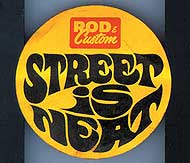
|

Our guys couldn’t hire a helicopter like we did in 1971...
|

...so they photographed the Pro’s Pick of ’01 from the rafters so we could get an overall shot of each event.
|
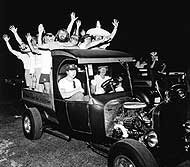
We were all in our teens, 20s, and early 30s when Jerry Stiles nailed the happy camper crew for the Minnesota Street Rod Association in their club C-Cab.
|
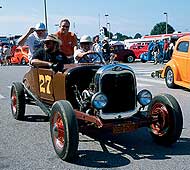
We’re still boppin’ around in Model Teez, proving that having fun in old cars hasn’t changed in 30 years.
|

There were no Pro’s Picks in Memphis ’71 because there were few, if any, professional car builders around. Instead, we had a Best Appearing award, and it went to a svelte Andy Brizio and his Instant T.
|
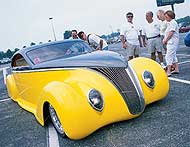
By contrast, Louisville had 12 PP’s, one of which went to the Tony Pisano/Boyd Coddington imitation ’37 Lincoln Zephyr.
|

Dale Jarrett may not wish to drive that flamin’ brown truck...
|
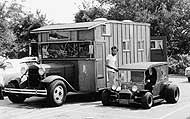
...but Jim “Brass Radiator” Babb drove Big Elmer housing Streetkana champ It-T-Bits all the way from Paramount, California, to Memphis. Babb and Vernon Walker were two of the few who supplied aftermarket radiators to the fledgling street rod movement.
|

The trio of TRODAS—Traditional Roadster Owners and Drivers Association—members, including Ron Weeks (’23 T), Bud Bryan (’29), and Jim Jacobs (Neikamp AMBR winner), found a lot of interesting VT (vintage tin) along the way.
|
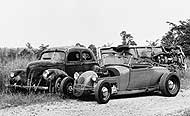
I wonder what the owners of those flamin’ Willys would give for this “in the weeds” ’37.
|

Hot licks and paint tricks are all a part of the scene, especially if they’re seen on ’40 Fords. Rod Powell was responsible for setting his circa-1971 Forty on fire.
|
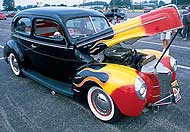
Not to be outdone is Dave and Vickie Kinnan’s clone of Bob McCoy’s flamous ’40 Tudor.
|
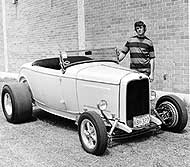
Gary Kessler and his high, wide, and awesome yellow Deuce highboy set the stage for hundreds of like-style roadsters.
|
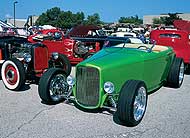
Today’s fender-free raggies are lower, slicker, and far more independent, proving that Henry’s $450 hair blower is still the quintessential hot rod.
|
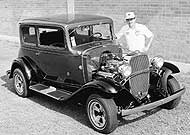
Little John Buttera once said, “Guys do Chevys because they couldn’t find a Ford.” However, Richard Tiebout and his wonderful ’32 Chevy Vicky showed the street rod clan what could be done with a Chebby...
|

...and now rodders like Indy’s Tim Bair and his ’40 Buick prove there’s no ride like a Bow Tie ride.
|
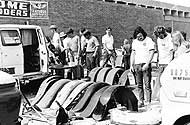
Other parts of street rodding that haven’t changed are swap meets and vintage tin. In 1971, Gene Scott and his Antique Auto caravan showed up in Memphis with loads of fenders, running boards, and grille shells...
|
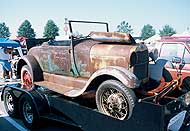
...but he brought no complete cars as shown here in 2001. They were back at his happy hunting grounds located in the Irwindale National VT Park.
|
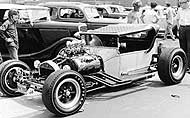
Cotton Werksman, one of the five original NSRA members, built this low-going Ardun T in the late ’60s. Well, if Werksman could do it, so can the guys today...
|
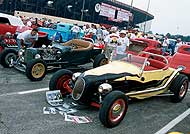
...including the dude who did as good a job at cloning Regg Schlemmer’s Jan. ’48 HRM cover car as Hot Rod did for its 50th Anniversary issue.
|
|



